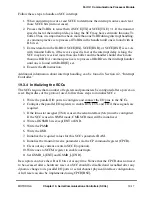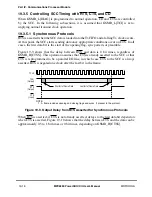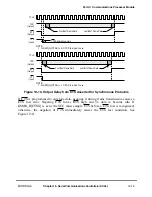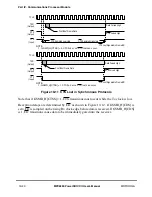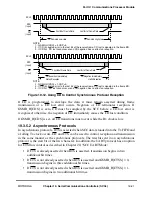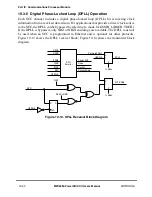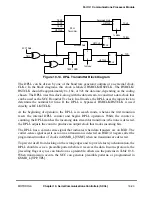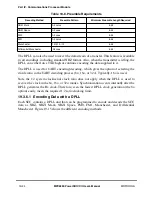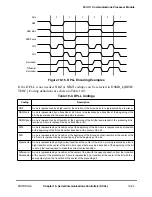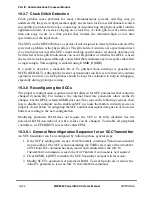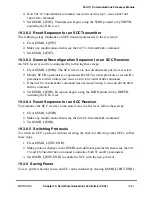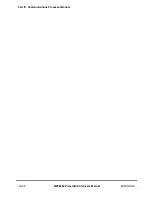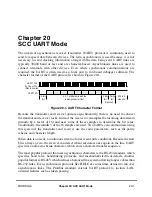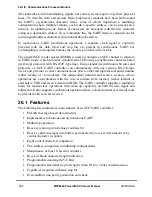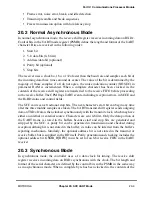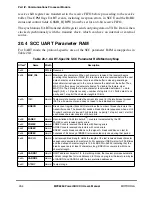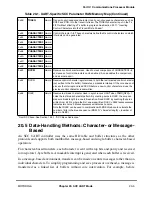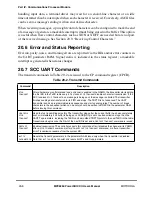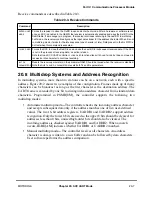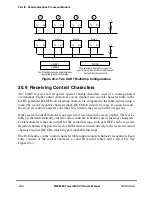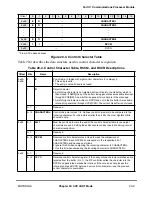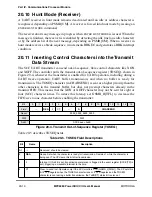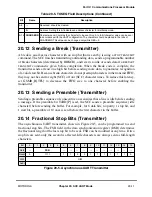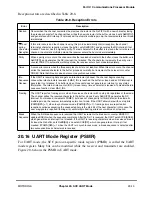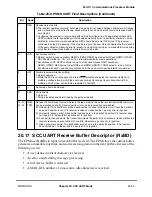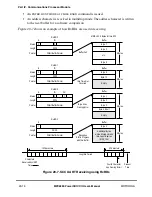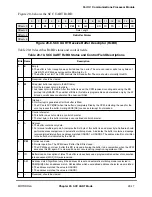
20-2
MPC8260 PowerQUICC II UserÕs Manual
MOTOROLA
Part IV. Communications Processor Module
All standards provide handshaking signals, but some systems require only three physical
linesÑTx data, Rx data, and ground. Many proprietary standards have been built around
the UARTÕs asynchronous character frame, some of which implement a multidrop
conÞguration where multiple stations, each with a speciÞc address, can be present on a
network. In multidrop mode, frames of characters are broadcast with the Þrst character
acting as a destination address. To accommodate this, the UART frame is extended one bit
to distinguish address characters from normal data characters.
In synchronous UART (isochronous operation), a separate clock signal is explicitly
provided with the data. Start and stop bits are present in synchronous UART, but
oversampling is not required because the clock is provided with each bit.
The general SCC mode register (GSMR) is used to conÞgure an SCC channel to function
in UART mode, which provides standard serial I/O using asynchronous character-based
(start-stop) protocols with RS-232C-type lines. Using standard asynchronous bit rates and
protocols, an SCC UART controller can communicate with any existing RS-232-type
device and provides a serial communications port to other microprocessors and terminals
(either locally or via modems). The independent transmit and receive sections, whose
operations are asynchronous with the core, send data from memory (either internal or
external) to TXD and receive data from RXD. The UART controller supports a multidrop
mode for master/slave operations with wake-up capability on both the idle signal and
address bit. It also supports synchronous operation where a clock (internal or external) must
be provided with each bit received.
20.1 Features
The following list summarizes main features of an SCC UART controller:
¥
Flexible message-based data structure
¥
Implements synchronous and asynchronous UART
¥
Multidrop operation
¥
Receiver wake-up on idle line or address bit
¥
Receive entire messages into buffers as indicated by receiver idle timeout or by
control character reception
¥
Eight control character comparison
¥
Two address comparison in multidrop conÞgurations
¥
Maintenance of four 16-bit error counters
¥
Received break character length indication
¥
Programmable data length (5Ð8 bits)
¥
Programmable fractional stop bit lengths (from 9/16 to 2 bits) in transmission
¥
Capable of reception without a stop bit
¥
Even/odd/force/no parity generation and check
Summary of Contents for MPC8260 PowerQUICC II
Page 1: ...MPC8260UM D 4 1999 Rev 0 MPC8260 PowerQUICC II UserÕs Manual ª ª ...
Page 66: ...lxvi MPC8260 PowerQUICC II UserÕs Manual MOTOROLA ...
Page 88: ...1 18 MPC8260 PowerQUICC II UserÕs Manual MOTOROLA Part I Overview ...
Page 120: ...2 32 MPC8260 PowerQUICC II UserÕs Manual MOTOROLA Part I Overview ...
Page 138: ...Part II iv MPC8260 PowerQUICC II UserÕs Manual MOTOROLA Part II Configuration and Reset ...
Page 184: ...4 46 MPC8260 PowerQUICC II UserÕs Manual MOTOROLA Part II ConÞguration and Reset ...
Page 202: ...Part III vi MPC8260 PowerQUICC II UserÕs Manual MOTOROLA Part III The Hardware Interface ...
Page 266: ...8 34 MPC8260 PowerQUICC II UserÕs Manual MOTOROLA Part III The Hardware Interface ...
Page 382: ...10 106 MPC8260 PowerQUICC II UserÕs Manual MOTOROLA Part III The Hardware Interface ...
Page 392: ...11 10 MPC8260 PowerQUICC II UserÕs Manual MOTOROLA Part III The Hardware Interface ...
Page 430: ...Part IV viii MOTOROLA Part IV Communications Processor Module ...
Page 490: ...14 36 MPC8260 PowerQUICC II UserÕs Manual MOTOROLA Part IV Communications Processor Module ...
Page 524: ...17 10 MPC8260 PowerQUICC II UserÕs Manual MOTOROLA Part IV Communications Processor Module ...
Page 556: ...18 32 MPC8260 PowerQUICC II UserÕs Manual MOTOROLA Part IV Communications Processor Module ...
Page 584: ...19 28 MPC8260 PowerQUICC II UserÕs Manual MOTOROLA Part IV Communications Processor Module ...
Page 632: ...21 24 MPC8260 PowerQUICC II UserÕs Manual MOTOROLA Part IV Communications Processor Module ...
Page 652: ...22 20 MPC8260 PowerQUICC II UserÕs Manual MOTOROLA Part IV Communications Processor Module ...
Page 668: ...23 16 MPC8260 PowerQUICC II UserÕs Manual MOTOROLA Part IV Communications Processor Module ...
Page 758: ...27 28 MPC8260 PowerQUICC II UserÕs Manual MOTOROLA Part IV Communications Processor Module ...
Page 780: ...28 22 MPC8260 PowerQUICC II UserÕs Manual MOTOROLA Part IV Communications Processor Module ...
Page 874: ...29 94 MPC8260 PowerQUICC II UserÕs Manual MOTOROLA Part IV Communications Processor Module ...
Page 920: ...31 18 MPC8260 PowerQUICC II UserÕs Manual MOTOROLA Part IV Communications Processor Module ...
Page 980: ...A 4 MPC8260 PowerQUICC II UserÕs Manual MOTOROLA Appendixes ...
Page 1002: ...Index 22 MPC8260 PowerQUICC II UserÕs Manual MOTOROLA INDEX ...
Page 1006: ......


